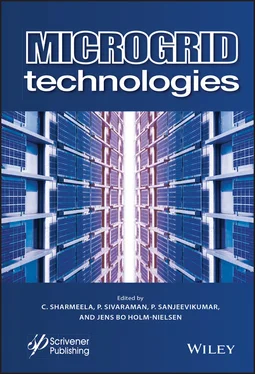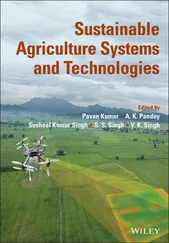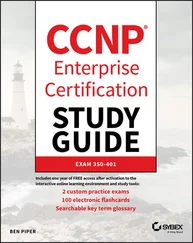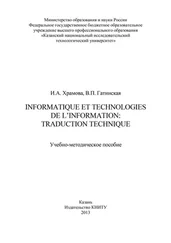4 Chapter 4Figure 4.1 Overall control structure of a single-phase grid-connected PV system.Figure 4.2 Basic structure of the PLL.Figure 4.3 Structure of the T/4 delay PLL.Figure 4.4 Inverse Park Transform based PLL.Figure 4.5 Enhanced PLL.Figure 4.6 Phase Detector of the SOGI PLL.Figure 4.7 Cascaded Generalized Integrator PLL (CGI-PLL).Figure 4.8 Cascaded Delayed Signal Cancellation Phase Locked Loop (CDSC-PLL).Figure 4.9 Basic Structure of Fuzzy Logic Controller.Figure 4.10 Single input and single output Fuzzy Logic Control Structure.Figure 4.11 Single input Membership function.Figure 4.12 3 × 3 Fuzzy Logic Control Structure.Figure 4.13 Membership function of 3 × 3 fuzzy set.Figure 4.14 5 × 5 Fuzzy Logic Control Structure.Figure 4.15 Membership function of 5 × 5 fuzzy set.Figure 4.16 Rule base for single input fuzzy set.Figure 4.17 Rule base for 3 × 3 fuzzy set.Figure 4.18 Rule base for 5 × 5 fuzzy set.Figure 4.19 Rule viewer for single input fuzzy set.Figure 4.20 Rule viewer for 3 × 3 fuzzy set.Figure 4.21 Rule viewer for 5 × 5 fuzzy set.Figure 4.22 SOGI two inputs and one output FLC PLL structure.Figure 4.23 SOGI two inputs and one output FLC PLL connected to a single phase i...Figure 4.24 (a) Inverter output voltage compared with grid voltage, (b) Grid cur...Figure 4.25 Test signal generator modelled in Matlab/Simulink.Figure 4.26 Test signal generator connected to SOGI FLC PLL.Figure 4.27 SOGI FLC PLL under no fault condition.Figure 4.28 SOGI FLC PLL under 3rd and 5th harmonic conditions.Figure 4.29 SOGI FLC PLL under 3rd and 5th harmonic with phase shift condition.Figure 4.30 SOGI FLC PLL under pulse interference.Figure 4.31 SOGI FLC PLL under modified pulse interference.Figure 4.32 SOGI FLC PLL under noise interference.
5 Chapter 5Figure 5.1 Classification of microgrids.Figure 5.2 The typical configuration of an AC microgrid.Figure 5.3 Typical power structure of a DC microgrid.Figure 5.4 The power structure of hybrid microgrid.Figure 5.5 Grid connected PV application: The DC–DC converter interface with MPP...Figure 5.6 (a) Wind generator of Squirrel Cage Induction Generator or Permanent ...Figure 5.6 (b) Wound Rotor Induction Generator with back–back converters.Figure 5.7 Application of boost converter in grid connected PV application.Figure 5.8 Typical I–V and P–V curves of a solar PV module.Figure 5.9 Flow chart of Perturb and Observe MPPT algorithm.Figure 5.10 Boost converter voltage and current waveforms.Figure 5.11 Interleaved boost converter configuration.Figure 5.12 Non-isolated step-down DC–DC converter.Figure 5.13 Buck converter voltage and current waveforms.Figure 5.14 Buck-boost converter configuration.Figure 5.15 Isolated DC–DC converters: (a) Flyback, (b) Push–pull, (c) Half-brid...Figure 5.16 DAB converter for isolated DC–DC conversion.Figure 5.17 EV charging using bi-directional DC–DC converter.Figure 5.18 Full wave diode rectifier circuits: (a) using two diodes, (b) using ...Figure 5.19 Output voltage waveforms: (a) without, (b) with DC-link capacitor.Figure 5.20 PWM rectifier or active rectifier.Figure 5.21 EV charging using bi-directional AC–DC converters: (a) without, (b) ...Figure 5.22 PWM VSC for converting DC to AC. (a) Single-phase half-bridge, (b) s...Figure 5.23 Control block diagram of three-phase VSC in reference frame.Figure 5.24 (a) PWM output voltage waveform, (b) the harmonic spectrum.
6 Chapter 6Figure 6.1 Battery equivalent electric circuit.Figure 6.2 Implantation of battery model in MATLAB/Simulink.Figure 6.3 Existing topologies: (a) Series connection, (b) parallel connection, ...Figure 6.4 First design having 5 switches per cell.Figure 6.5 A series-connected reconfigurable battery pack.Figure 6.6 A Self-X reconfigurable multi-cell battery pack.Figure 6.7 Schematic diagram of DESA.Figure 6.8 Genetic algorithm based topology.Figure 6.9 Graph based topology and paths as graph representation.Figure 6.10 4S configuration-based order of switching.Figure 6.11 4S to 4P configuration-based faults occurring switches.Figure 6.12 4P configuration-based order of switching.
7 Chapter 7Figure 7.1 SLD of micro grid system.Figure 7.2 SLD of micro grid in ETAP.
8 Chapter 8Figure 8.1 A sample of islanding microgrid design.Figure 8.2 Analyzing electrical component in positive, negative and zero sequenc...Figure 8.3 Symmetrical fault diagram.Figure 8.4 Three-Phase symmetrical fault sequence diagram.Figure 8.5 Single line-to-ground fault diagram.Figure 8.6 Single line-to-ground fault sequence diagram.Figure 8.7 Line to line fault diagram.Figure 8.8 Line-to-line fault sequence diagram.Figure 8.9 Double line-to-ground fault diagram.Figure 8.10 Double line-to-ground fault sequence components.Figure 8.11 IEC Standard Inverse (SI) operating curve.Figure 8.12 Directional characteristics for phase to ground fault.Figure 8.13 Directional characteristics for double line to ground fault.Figure 8.14 Typical distance protection quadrilateral operation settings.Figure 8.15 Distance protection logic.Figure 8.16 The quadrature distance protection test graph for phase to ground fa...Figure 8.17 Distance trip time test graph for phase to ground fault.Figure 8.18 The quadrature distance protection test graph for double line to gro...Figure 8.19 Distance trip time test graph for double line to ground fault.Figure 8.20 The distance accelerating scheme for OHTL between the microgrid and ...Figure 8.21 Programing the acceleration scheme by the numerical protection relay...
9 Chapter 9Figure 9.1 Block diagram of control strategy.Figure 9.2(a) Overview of simulated Microgrid.Figure 9.2(b) Architecture of single DG unit connected to a synchronous generato...Figure 9.3 Frequency response for sudden load variation with less low penetratio...Figure 9.4 Battery and supercapacitor power for sudden load change with less RES...Figure 9.5 Normalized S.O.C graphs.Figure 9.6 Governor response.Figure 9.7 Change in solar power.Figure 9.8 Frequency response for P.V. change.Figure 9.9 Governor response for P.V change.Figure 9.10 Normalized S.O.C graphs.Figure 9.11 Frequency response for sudden load variation with high penetration o...Figure 9.12 Battery and supercapacitor power for sudden load change with high RE...Figure 9.13 Normalized SOC of battery and supercapacitor.Figure 9.14 Governor response for sudden load change with high RES share.Figure 9.15 Solar power variation.Figure 9.16 Frequency response for PV.Figure 9.17 Governor response.Figure 9.18 Normalized S.O.C graphs.Figure 9.19 Fuel cell active power variation for deloading technique.
10 Chapter 10Figure 10.1 Schematic arrangement of Microgrid.Figure 10.2 Structure of a DC microgrid.Figure 10.3 Structure of AC microgrid.Figure 10.4 Structure of hybrid microgrid.Figure 10.5 33 bus microgrid.Figure 10.6 Radial line power flow.Figure 10.7 Voltage Profile before RES inclusion.Figure 10.8 Solar power generation.Figure 10.9 Wind power generation.Figure 10.10 Voltage Profile after RES inclusion.Figure 10.11 Voltage Profile comparison.Figure 10.12 Non-linear loads connected to DG’s.Figure 10.13 (a) Current waveform distortion level with linear load. (b) Distort...Figure 10.14 (a) Voltage waveform with non-linear load. (b) Distortion level of ...Figure 10.15 (a) Current waveform with non-linear load. (b) Distortion level of ...Figure 10.16 Microgrid connected with SAPF.Figure 10.17 Generation of gating pulse with Fuzzy-PI controller.Figure 10.18 GWO community ladder.Figure 10.19 Flowchart for updating search agent in GWO.Figure 10.20 (a) Current waveform with compensation. (b) Distortion level of cur...
11 Chapter 11Figure 11.1 Structure of general Microgrid.Figure 11.2 Basic diagram of wind turbine.Figure 11.3 Flow chart representation of P&O technique.Figure 11.4 DC–DC converter MPPT controller.Figure 11.5 Single line diagram of UPQC.Figure 11.6 Structure of proposed PSO based UPQC Series control diagram.Figure 11.7 Control structure of the shunt inverter.Figure 11.8 Algorithm for PSO technique.Figure 11.9 Structure of Proposed Microgrid System with UPQC.Figure 11.9 Simulation result for active and reactive powers with PI based UPQC.Figure 11.10 Simulation result for Grid Voltage and Grid Current.Figure 11.11 Analysis of the (a) Voltage swell, (b) Injected voltage and (c) Out...Figure 11.12 Simulation result for active and reactive powers with PSO technique...Figure 11.13 Simulation result for Grid Voltage and Current due to change in loa...Figure 11.14 THD for Non-Linear Current without UPQC.Figure 11.15 THD for Non-Linear Current with UPQC PI controller.Figure 11.16 THD for Non-Linear Current with UPQC PSO controller.
Читать дальше











